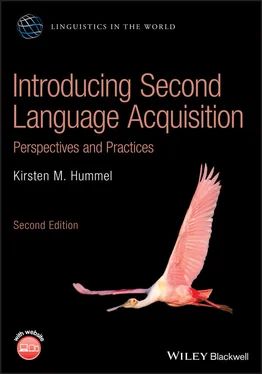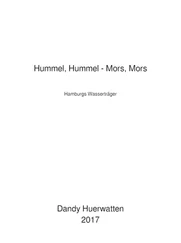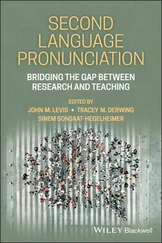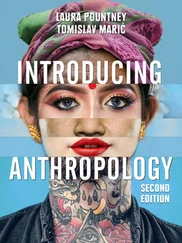child‐directed speech (CDS)
Special speech register used by adults and older children when speaking to younger children and infants. Characteristics include exaggerated intonation and considerable repetition.
Allison:
Tumble (takes doll out of truck; knocks truck over).
Mother:
Tumble, tumble. Where is the truck going to go? Where will the truck go?
Allison:
brrm.
Mother:
Where?
Allison:
Pop Pop.
Mother:
Pop Pop? To see Pop Pop?
Allison:
No.
Mother:
No. Where will the truck go?
The mother in the preceding dialogue uses CDS when she repeats words (“tumble, tumble,” “pop pop”) and repetitive utterances are largely questions (“Where is the truck going to go?” “Where will the truck go?” “Where?”). The extent to which such adaptations help, hinder, or are neutral to a child's L1 progress is under debate, but many researchers suggest that CDS may in fact make it easier for the child to pick out the important segments in speech. Studies have found, for instance, that children with mothers who tend to talk more per unit of time display a more rapid vocabulary growth (e.g. Huttenlocher et al. 1991). CDS has been found to occur across languages. For example, in a study of Mandarin speakers in Taiwan (Liu et al. 2009), it was found that mothers used longer vowels, higher pitch and greater lexical tone differences when speaking with their children.
The interactionist approach has been criticized for making certain assumptions that remain untested. In essence, the critique is made that CDS is actually not all that simple and therefore may not be inherently helpful in allowing the child to acquire language. Still, there is evidence from Inuktitut, a language spoken by Inuit people in the Arctic, that CDS can be structurally quite complex, yet still appears to facilitate children's acquisition of morphology in that language (Crago and Allen 1998). It has also been pointed out that some CDS features have not been found in a number of languages. If CDS is a necessary feature to allow for optimal language acquisition, one would expect to find it universally, cross‐culturally, and this is not the case. Ochs (1985), for instance, found little importance given to speech modifications to infants in Samoan society. Other studies have focused specifically on examining whether there is a direct relation between aspects of CDS and language gains. In this regard, Hoff‐Ginsburg (1986) found no relation between the complexity of the mother's speech and children's language gains.
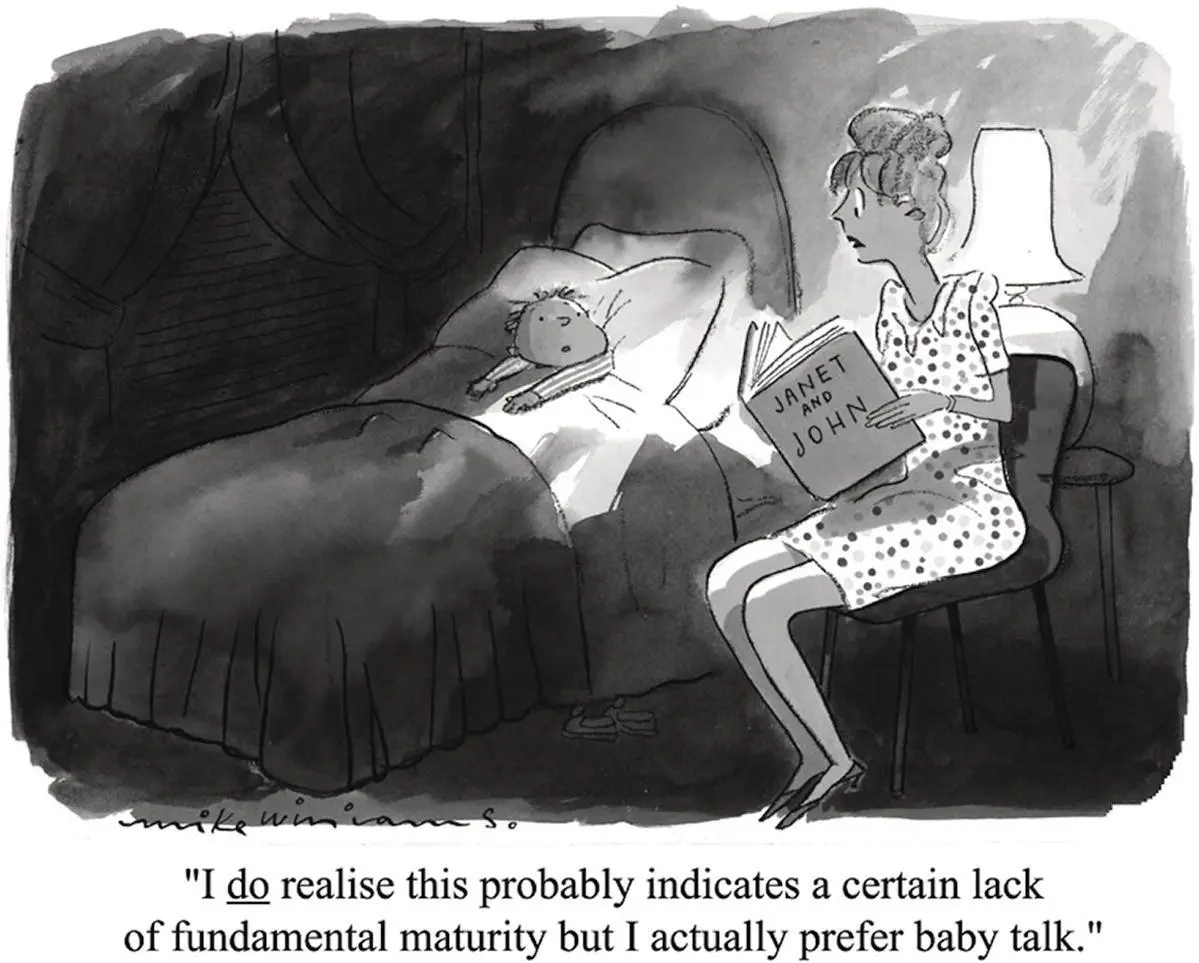
Cartoon 2.2Mike Williams/CartoonStock.com.
2.4.4 emergentism: connectionist viewpoint
A relatively recent theoretical view concerning language acquisition stems from what has been termed emergentism. In this perspective, “language development is no longer seen as a process of acquiring abstract rules, but as the emergence of language abilities in real time …” (Evans 2009, p. 128). A language‐specific learning device is not considered to be innately specified, as proposed by the UG approach. Instead, inspired by the structure of the nervous system, proponents of this view suggest that language emerges out of a complex network of interconnections between neurons (e.g. Elman et al. 1996).
emergentism
Theoretical view proposing that phenomena of language are best explained by reference to more basic nonlinguistic factors and their interaction (e.g. physiology, perception, processing, input properties, etc.).
One predominant emergentist‐inspired model is connectionism, which proposes that language is learned through exposure to language in the environment, the input. This exposure allows the construction of associations among units, i.e. sound sequences, words, sentence patterns, etc. The L1 develops, therefore, through ongoing exposure to language in the environment with increasing exposure to certain units leading to greater associative strengths. When the associations are strong enough, the units and patterns become permanently acquired. One often‐cited test of this model (Rumelhart and McClelland 1986) used computer simulation to examine past tense acquisition on verbs and found that the model predicted learning sequences found in typical L1 English past tense acquisition: i.e. U‐shaped learning (referred to in Section 2.3) in which the correct irregular past tense form “went” appeared first, followed by the incorrect over‐regularization “goed” or “wented,” finally returning to the correct form “went.” The connectionist viewpoint therefore suggests overregularization behavior can be explained by the child's sensitivity to the frequency of the forms in the input, in contrast to the UG approach which uses such examples as evidence of an underlying rule system.
connectionism
Theoretical view proposing that language is learned through exposure to input allowing the construction of associations among units, i.e. sound sequences, words, sentence patterns, etc.
There are both supporters and critics of this relatively recent approach. While there is evidence that the model may account for specific aspects of L1 learning such as irregular past tense forms, as indicated in the preceding paragraph, the connectionist model is still in the early stages of testing. One specific critique is that it is not clear how connectionism can account for the effect of nonlinguistic, contextual information, such as tone of voice, gestures, etc., in language acquisition (Tomasello, cited in Paradis 2004). Chapter 5will discuss emergentist approaches with regard to their relevance to L2 acquisition.
There are of course other theoretical views on language acquisition, but the ones discussed briefly in this section can be considered as particularly relevant for the examination of second language acquisition that we will undertake in the following chapters.
2.5 first language vs second language acquisition
On one hand, there are remarkable differences that characterize the L1 and L2 learning situations. On the other, there is much that is similar in terms of the learning process. Indeed, historically there have been periods when it has been claimed that learning a second language is very similar to learning a first language. For instance, behaviorist views, as articulated most notably by the psychologist Skinner mentioned in the previous section, led to the perspective that the two acquisition processes were basically similar, except for the fact that first language habits needed to be purged during the L2 learning process. On the other hand, views advocated in other periods have tended to emphasize the differences between L1 and L2 learning. In this section we will draw attention to some of the important ways in which L1 and L2 acquisition differ, and ways in which they resemble each other. Note that we will examine the simultaneous acquisition of two first languages in Chapter 10, which discusses bilingualism.
2.5.1 L1 acquisition vs L2 acquisition contrasts
There are important differences characterizing the L1 and L2 acquisition situations. In this section, we will point out some dimensions along which learning a second language and learning a first language can be distinguished.
One very noticeable dimension of difference is that of age. Essentially all L1 learners are exposed to their first language in the earliest stages of life at a time when many other developmental processes are just beginning to appear. The infant has no other repertoire of signals to rely on, other than basic sounds, some gestures, and reflexive noises. The development of the brain and cognition are at an early stage; infants are incapable of advanced reflective thinking and planning. Thus language is an intrinsic component of the child's overall cognitive and social development. As the child develops, basic cognitive capacities increasingly emerge. Piaget, a Swiss psychologist, meticulously described and documented the various cognitive stages that young children go through, based on his clinical observations. For instance, he found that the one‐year‐old child has attained certain cognitive landmarks, such as object permanence, meaning that the child understands that objects which are no longer visible, as when a toy slips under the sofa, have not simply vanished from the universe, but can be found by peeking under the furniture. Similarly, the one‐year‐old is generally able to grasp the relationship between means and ends, as in comprehending that using a particular tool will allow him or her to attain an objective. Symbolic play, in which a child uses an object to imitate another object, emerges during the second year and indicates that the child is capable of increasing mental abstraction in representing objects. Thus the child's developing language accompanies her unfolding cognitive abilities; certain cognitive attainments coincide with language markers associated with those cognitive stages. For example, when a child acquires the means‐end concept, words marking success or failure, such as “there” and “uh‐oh” tend to appear in the child's vocabulary (Gopnik and Meltzoff 1993). Gopnik and Meltzoff (p. 243) claim that “[c]onceptual developments are not just prerequisites for semantic developments. Instead, linguistic variations may actually influence cognitive developments.” It is possible that children's early words and phrases influence and perhaps even shape their perception and cognitive development, that is, using “there” to emphasize her success in using a tool to reach an otherwise out‐of‐reach teddy bear might actually contribute to a child's understanding the concept that certain means or tools can be used to achieve results.
Читать дальше
